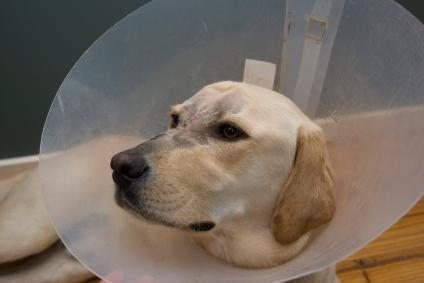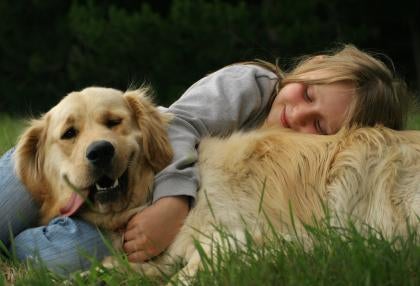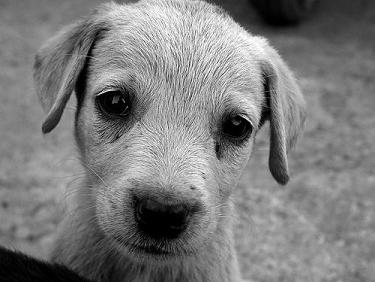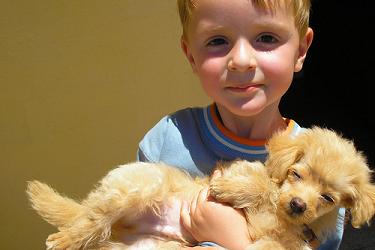Identify & Treat Your
Dog's Skin Problems
Is your dog constantly biting, itching, gnawing, or scratching?
Well you are definitely not alone! Dog skin problems are very common in our canine companions. Unfortunately, the prevalence of this behavior has owners believing it is their dog's normal manner - thus far too many dogs go untreated. Skin irritations are uncomfortable and unnecessary. Sometimes the solution is simple. With the right diagnoses and treatment for recovery, your dog can soon be comfortable again.
How To Control Dog Fleas
Check out your dog's behavior. Is he frequently gnawing at the area above his tail? If so, chances are he simply has fleas. Fleas are pesky little devils, but the good news is that it has become very easy to rid them from your dog's back.

You can buy topical flea solutions, or oral pills over-the-counter at any vet hospital and some pet stores. The topical drops are applied on the dog's neck, where he is unable to lick, directly on the skin. The two most common flea control brands are Frontline and Advantage. Frontline is a bit more expensive than Advantage because it also kills ticks and is water resistant in fresh water.
If your dog is a body surfer in the ocean, then you may need to apply Frontline every 3 weeks instead of the recommended once a month because salt water can strip it from his coat. Never treat your dog more than every 3 weeks however, due to the harsh chemicals. Fleas have been known to grow immunities to flea medicine after a while. This happens through the birth of one mutant immune flea that breeds with another flea. All of the eggs from the two can be born immune to the product. If this is the case, then switch to Promeris. Promeris has an entirely different active ingredient in it than any other topical flea medicine so it will quickly wipe out your freaky little flea infestation. If you have any cats at home then do not let them lick the Dog Promeris off his back because the chemicals can be toxic to cats.
Capstar is an oral pill that will kill the fleas instantly off the back of your dog within 30 minutes but it only lasts 24 hours. It can be given as often as once a day with no risks. You should always have a box on hand to give him one before he gets social at the beach, dog park, or kennel to prevent getting fleas from his dog fiends.
Each female flea has been known to drop 30 eggs a day! Most of those eggs fall into your carpet. To kill the flea eggs in the carpet you can buy Borax found down any laundry isle. Before vacuuming, sprinkle a moderate amount into your carpet and scuff it in with your feet to scratch up the existing eggs so they will be unable to hatch. Flea dips and flea shampoos do not work. They are the old fashioned method of flea control. The modern day consensus is that their chemical solutions can cause more harm than good.
The Truth About Dog Mange
If your dog's skin problem has him licking himself before leaving patches of hair missing then a type of Mange could possibly be the cause. Every dog is born with a normal amount of skin mites. If he has a weak immune system (a genetic trait common in purebreds) then the mites can overgrow. This type of Mange is called Demodex and is not contagious.
If he has had contact with an infected dog, or was recently adopted from the pound in a scrappy state, then he might have the contagious type of mange called Scabies. Mange is positively identified under a microscope at the vet through a skin scrape. Both kinds of Mange have been known to clear up with a simple diet change and a good dandruff shampoo. Give your dog the best nutritious dog food you can find in conjunction with fatty acids, fish oil, and vitamins. Selsun Blue is a decent product to shampoo him with. If you still are unable to control the Mange then your vet can prescribe you some Ivermectin. Ivermectin is an anti-parasite medication and it works faster to clear up Scabies than Demodex.
Dog Skin Allergies
The last type of cause for your dog's skin irritation is allergies. This can be the most frustrating issue to diagnose because you need to identify if the problem originates from environmental, food, or flea allergies.
Environmental allergies will often have your dog chewing his side, back, or belly creating bald inflamed patches of skin called hot spots. Does your dog like swimming in ponds, or lakes, or hang out in the rain? The frequent moisture can be a contributor, especially with dense coated dogs. A type of hot spot is moist eczema, where the skin lesions occur from moisture on the skin that remained long enough to allow bacteria to reproduce.
Different types of grass and thistles have been a common cause of flare-ups for dogs with an environmental allergy. Dust mites, or pollen could be the root of the problem. Is the lawn at the dog park sprayed with pesticides?
Environmental allergies are hard to identify without the help of proper testing. If you have ruled out any patterns of hot spots coinciding with your dog's daily activities and are still at a loss of the cause, then you can get a VARL blood test done at the vet. The VARL test results will give you the break down of the environmental distresses to your dog. It gives a ranking of 1-10 on how allergic your dog is to each plant in your area. VARL then offers specialized allergy shots customized to the results.
If it turns out your dog is allergic to sun exposure (common in white purebreds), or grass, then there are companies who design special dog sweaters, sunscreen, and boots to protect him. You can spray Betegen Spray directly on his hot spots to alleviate the burn sensation. Betegen Spray can sometimes be found without a prescription at pet stores or sold over the counter at vet hospitals.

Dog Food allergies will have your puppy chewing at the center of his paws, shaking his head due to chronic ear infections, and scratching wildly at his whiskers. Identify what kind of kibble you are feeding him. What type of treats does he eat? Is he receiving any food scraps?
Most food allergy skin irritations are derived from a hypersensitivity to the protein in the diet. To run a food trial you need to completely switch him from the protein he is currently eating to a kibble of an entirely different protein. The new food should be fed consistently for 10 to 16 weeks to see the full effect. NO treats, bones, or scraps should be given during this process because even the smallest amount of conflicting protein will totally eradicate the effects of the food trial.
Meanwhile, you should be rinsing out his ears with Chlorhexiderm Flush. You can find this at every pet store. It is always a good idea to flush his ears out before and after he goes swimming or gets bathed. Dogs have L-shaped ear canals that go beyond the reach of the common Q-tip. Water gets trapped in the lower part of the canal and this is how bacteria and yeast infections develop. Dogs with food allergies get an overgrowth of their body's normal yeast growth so they are exceptionally prone to yeast infections in their ears. You can tell by the distinct chalky smell.
Spray the inside of his paws with Betegen Spray as often as once a day to clear up the pink inflammation. Elizabethan collars and baby socks make it harder for your dog to gnaw at his paws.
If the food allergy is out of your control, then the vet may prescribe Prednisolone, which is an anti-inflammatory steroid medication used to control the side effects of the allergy. Most are given in tapering doses. You will notice your dog having to urinate much more frequently on this med. Steroids are very powerful and can have lasting negative effects on his internal organs, especially if they are given frequently over long periods of time. If you give him Prednisolone only a few times while he is young, then the lasting effects are less risky. The vet will also give you Mometamax to drop into his ears to alleviate the inflammation and irritation. You may get some antibiotics as well. A cortisone shot will eliminate your dog's symptoms for nearly a month at a time but can be extremely harsh on his liver.
Flea Allergies can look like a rash, hot spots, or small red scabs and welts. Your dog may act obsessive with chewing and itching even if no fleas are living in his fur. Your dog's whole reaction can be ignited by only one fleabite if he has flea allergies.
It is best to use the preventative measures mentioned earlier to ensure that your dog will not have to worry about a single flea affecting him. If you have ruled out the other two allergies and are certain your dog has a flea allergy then there is no need to set up an appointment at the vet. The vet would just sell you a prescription flea shampoo but a soothing aloe and oatmeal shampoo will work just as well.
If your dog's skin and coat are not in optimal condition then the right measures should be taken to relieve your pets annoying Dermatitis inflammation. Discomfort causes stress and unease, which can lead to many other health issues. If left untreated, any skin irritation can become dangerous if it gets infected. He will thank you when he can finally sleep through the night again without having to scratch himself to shreds!








 Dogs are a naturally aggressive species. Before domestication, aggression was extremely handy for dogs. Dogs must have aggression to hunt, to defend their food, to mate, etc...
Dogs are a naturally aggressive species. Before domestication, aggression was extremely handy for dogs. Dogs must have aggression to hunt, to defend their food, to mate, etc...
 1. Get your dog certified as a therapy dog and then start visiting hospitals, nursing homes or group living facilities. Organizations offering certification include: Bright and Beautiful Therapy Dogs, Therapy Dogs International and Delta Society.
1. Get your dog certified as a therapy dog and then start visiting hospitals, nursing homes or group living facilities. Organizations offering certification include: Bright and Beautiful Therapy Dogs, Therapy Dogs International and Delta Society. 3. Don’t equate love with food. Those extra treats don’t build your bond with your pet, they only build love handles on your pet. In 2010 resolve to base your relationship with your pet on fun, not food. For a treat throw a ball to your dog or scoot the laser pointer up and down the wall to entertain your cat. Remember that cats have short attention spans so vary the activities in each play session.
3. Don’t equate love with food. Those extra treats don’t build your bond with your pet, they only build love handles on your pet. In 2010 resolve to base your relationship with your pet on fun, not food. For a treat throw a ball to your dog or scoot the laser pointer up and down the wall to entertain your cat. Remember that cats have short attention spans so vary the activities in each play session. 5. Quitting smoking may already be on your list of New Year’s resolutions, and you should follow through on it not just for you, but for your pet! Veterinary researchers have documented that dogs and cats living in a household with a smoker do passively inhale smoke because they have elevated levels of nicotine metabolites in their urine. In cats, second-hand smoke has been also been associated with a greater risk of developing lymphoma and oral squamous cell carcinoma.
5. Quitting smoking may already be on your list of New Year’s resolutions, and you should follow through on it not just for you, but for your pet! Veterinary researchers have documented that dogs and cats living in a household with a smoker do passively inhale smoke because they have elevated levels of nicotine metabolites in their urine. In cats, second-hand smoke has been also been associated with a greater risk of developing lymphoma and oral squamous cell carcinoma. 7. Resolve to spend your pet’s budgeted dollars wisely. When visiting the veterinarian, make a list of questions to keep your appointment on track to get all your questions answered. Evaluate the feasibility of pet insurance with coverage for routine healthcare. ___________________________________________
7. Resolve to spend your pet’s budgeted dollars wisely. When visiting the veterinarian, make a list of questions to keep your appointment on track to get all your questions answered. Evaluate the feasibility of pet insurance with coverage for routine healthcare. ___________________________________________